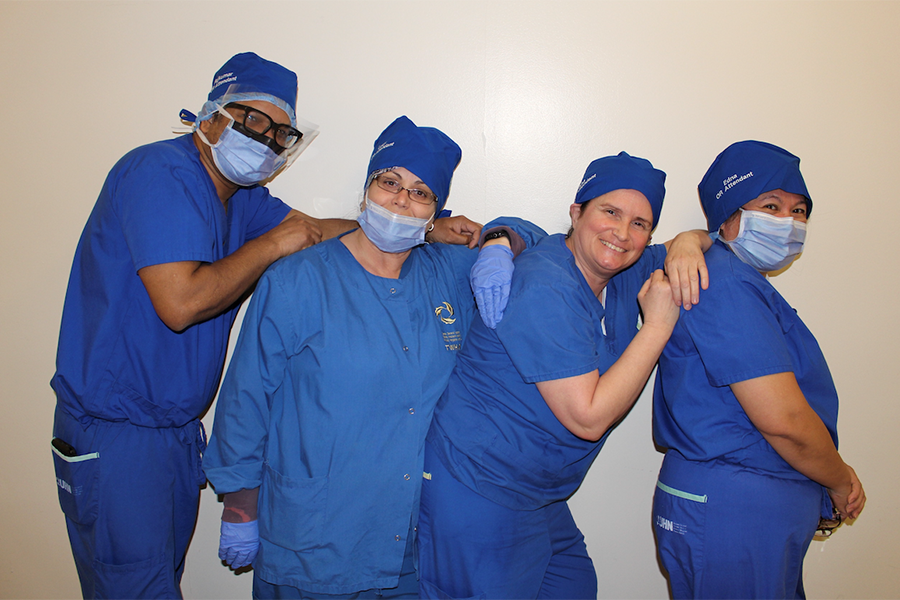Dr. Gonzalo Sapisochin performs living donor liver transplants in cancer patients. Dr. Ian McGilvray leads liver and pancreas surgery at Sprott Surgery.
Doctors are using living donor liver transplants to save patients with cancer.
By Tamar Satov
It’s late in the evening on Mother’s Day 2017, and Sandra Elhilali is sitting with a radiologist, counting the tumours on a scan of her liver. She should have been celebrating the day at the lake with her husband and kids, but the 42-year-old had been feeling unwell for several months, not eating and sleeping all hours. A trip to the ER that morning revealed the shocking cause: Stage 4 colorectal cancer with metastasis to the liver. “…16, 17, 18, 19…” The radiologist stops at 20, realizing it’s pointless to continue.
Elhilali is immediately admitted to her local hospital to begin chemotherapy in a palliative setting and is told she might never return home to her family. “It was the absolute worst possible scenario,” she recalls, her voice breaking.
What Elhilali didn’t know at the time, however, was that at Toronto General Hospital, Dr. Gonzalo Sapisochin, a transplant surgeon with the Sprott Department of Surgery who is also part of the Soham & Shaila Ajmera Family Transplant Centre, had just launched a clinical trial to perform living donor liver transplants on patients just like her – a groundbreaking procedure that would eventually save her life.
Leaders of living donor liver transplants
Sprott Surgery is home to a team of surgeons who are experts at living donor liver transplants. They perform about 70 a year, making it the largest such program in the western world. Unlike with other organs, someone can donate 70 per cent of their liver to another person, and then have it regrow to regular form in a few weeks or months. “The liver is the only organ in the body that regenerates,” explains Dr. Sapisochin. “You can donate most of a liver to a person, and both livers will quickly regenerate almost to normal size.”
These transplants are already routinely done on patients with inoperable primary liver cancer, but living donor liver transplants are not usually the standard of care for individuals like Elhilali, who have colorectal cancer that has spread to the liver.
It’s an unfortunately large cohort of patients, often with poor prognoses. Of the more than 25,000 Canadians diagnosed with colorectal cancer each year, about half will see the disease spread to their liver because blood drains directly from the colon to the sponge-like organ, which effectively soaks up the cancer cells. For 60 to 80 per cent of these patients, surgical removal of the liver tumours is impossible, because the size and number of tumours are too great, and it’s too difficult to leave an adequate amount of normal functioning liver. As a result, only five to 10 per cent of patients will be alive five years after their diagnosis.
A new era in transplant oncology
Research conducted in Oslo, Norway, has shown that patients with inoperable liver metastases from colorectal cancer who receive a liver transplant have a five-year survival rate of 60 per cent. Transplantation hasn’t been an option for these patients in Canada, however, due to a chronic shortfall of deceased liver donors – about 30 per cent of Canadians waiting for a liver transplant die before they can get one.
Because livers are in such short supply, Dr. Sapisochin and his team set up the clinical trial in August 2016 to see if living donor liver transplants could become an effective treatment for these patients. While still investigational, the early results of the trial are promising. “We have done two so far, and both patients are doing well,” he says, noting that the first patient, who is 16 months post-op, had a recurrence of cancer in their lungs, but it is treatable and the patient is enjoying a good quality of life. The second patient, who had her transplant a month later, was Elhilali.
Renewed hope
About a year after her diagnosis, chemotherapy and surgery had successfully eradicated the cancer in Elhilali’s colon, but her liver was still full of tumours. “It looked like a spotted Dalmatian,” she recalls. “I knew I would have to look at alternative solutions.”
In June 2018, she was referred to the University Health Network (UHN) clinical trial and met with Dr. Sapisochin. “We discussed the possibility of a living donor liver transplant and all it would entail,” she says. “I came away from that meeting with a renewed sense of hope, knowing if I had to entrust my life to anyone’s hands, I could not find a safer place.”
But there was still a long road ahead. To qualify for a transplant, trial candidates must be monitored for at least six months to ensure their cancer remains stable and has not spread to other organs, and they need to find someone they know who is willing to be a living donor, is in good health and has a matching blood type.
After months of waiting to find a match, Elhilali learned in March 2019 that her first cousin got the green light. Two months later, he would give her the right lobe of his liver.

Sprott surgeons perform hundreds of transplants every year.
The surgical process
The transplant team began early in the morning with a five-hour operation on Elhilali’s cousin, removing the designated portion of his liver. It’s a complicated but safe procedure; of the nearly 1,000 living liver donors who have been through UHN, fewer than five per cent have had any complications, and mortality is zero.
Elhilali’s eight-hour transplant was timed to happen immediately after her cousin’s, since a donated lobe can only survive outside the body for a maximum of 12 hours. “It’s a challenging operation,” says Dr. Ian McGilvray, Head of Liver and Pancreas Surgery in the Division of General Surgery in the Sprott Department of Surgery and Research Director of the Soham & Shaila Ajmera Family Transplant Centre. “The liver is a large organ smack dab in the middle of the body, and our major blood vessels are attached to or run through it, carrying a phenomenal amount of blood.”
To prevent blood loss, the surgeons must carefully clamp the various arteries and veins as they cut out the diseased liver, ensuring they leave enough length on the blood vessels to enable grating of the donated lobe. Each graft involves extremely fine sutures around the front and back walls of the tiny blood vessels, viewed through microscopic goggles. Finally, the bile duct must be attached, and the clamps removed to restore blood flow.
After the surgery was done, Elhilali was observed in hospital for about two weeks to make sure none of the sutures were leaking, there were no infections and that she was responding well to the immunosuppressant drugs that would prevent her body from rejecting the new liver. “I’ve been doing transplants for 17 years, but I still think it’s really freaking cool that we can do this at all – it blows my mind,” says Dr. McGilvray. “Even 10 years ago we wouldn’t have been thinking of doing anything like this. Someone with metastatic colon cancer, we’d tell them, ‘Go home and get your affairs in order.’ The way we treat cancer has changed so much.”
A new lease on life
Elhilali will continue to be monitored for five years as part of the clinical trial, but so far, she has remained cancer-free. “I am forever grateful and blessed for this second chance at life,” she says. “Every moment I get to spend with my children, sharing adventures and simple moments, or seeing the world, is a gift I will cherish forever.”
Dr. Sapisochin hopes to include 20 patients in the trial by 2023, and is about to launch an international registry so doctors in other countries who may conduct similar trials can share information. “We’ll be able to analyze all the cases in detail and learn from them,” he explains, “so we can offer this treatment in the best way to our patients.”
Generous donors
2,782 Organ transplant procedures across Canada done in 2018 (Source: Canadian Institute for Health Information)
This article originally appeared in the Sprott Department of Surgery magazine.
Photos by Tim Fraser.


